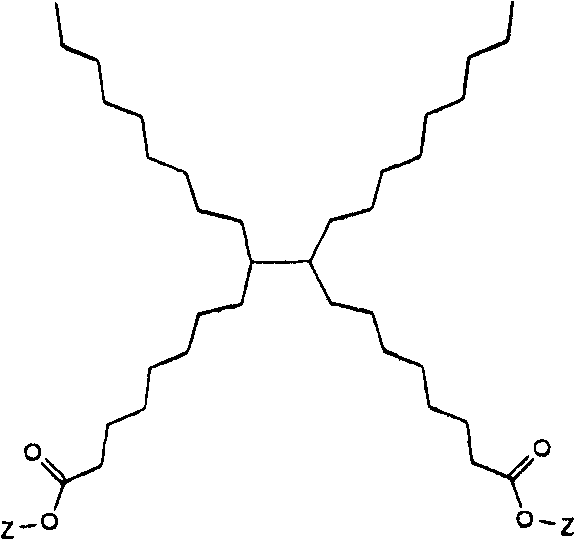Radiation curable ink containing fluorescent nanoparticles
A fluorescent nanoparticle, radiation curing technology, used in inkjet printing, UV curable composition, radiation curable composition field, can solve the problem that ink cannot be used for inkjet, blocked inkjet nozzles, etc.
- Summary
- Abstract
- Description
- Claims
- Application Information
AI Technical Summary
Problems solved by technology
Method used
Image
Examples
Embodiment 1
[0170] Synthesis of fluorescent pigment-benzo[k,l]thioxanthene-3,4-dicarboxylic anhydride
[0171] Introduce 4g (0.016mol) 4-nitronaphthalene tetracarboxylic anhydride, 3mL (0.03mol) 2-amino-thiophenol and 40mL N,N-Dimethylformamide. A dark brown solution was produced. Isoamyl nitrite, 3.2 mL (0.024 mol) was slowly added to the flask via syringe. The temperature of the reaction mixture increased to 80°C and an orange precipitate formed. At the end of the addition, the temperature in the flask was allowed to drop to 60°C. The reaction mixture was then stirred at this temperature for 3 hours to ensure completion of the reaction. The solid was filtered through fritted glass and washed twice with N,N-dimethylformamide and once with N,N-dimethylformamide:distilled water in a weight ratio of 1:1 until the washings were clear. The orange solid was dried overnight in a vacuum oven at 100°C. Infrared spectroscopy using KBr pellets gave the following data: 1758 cm -1 and 1721cm -1...
Embodiment 2
[0178] (1) Preparation of polyester latex.
[0179] Weigh 190g of amorphous propoxylated bisphenol A fumarate resin (Mw=12,500, initial Tg=56.9, acid value=16.7; TM Resin was purchased from Reichhold Chemicals, Inc.), RESAPOL HT from Resana S.A., and 10 g of DFKY-C7 (Risk Reactor) fluorescent dye. 100 g of methyl ethyl ketone and 40 g of isopropanol were independently weighed out and mixed together in a beaker. The solvent was poured into a 1 L kettle containing the resin. The covered kettle, liner, condenser and 2 rubber stoppers were placed in a water bath set at 48°C for 1 hour. A fluke impeller was placed in the kettle and turned on to rotate at approximately 150 RPM. After 3 hours, when all the resin had dissolved, 8.69 g of 10% NH 4 Oh. The mixture was stirred for 10 minutes. 8.0 g of Vazo 52 thermal initiator were then added to the mixture and the mixture was stirred at 48°C for an additional 10 minutes. Next, 600 g of deionized water was added to the kettle via ...
Embodiment 3
[0184] A surfactant solution consisting of 3.0 g of Neogen RK (anionic emulsifier) and 250 g of deionized water was prepared by mixing for 10 minutes in a stainless steel hopper. The reservoir was then purged with nitrogen for 5 minutes before being transferred into the reactor. The reactor was then continuously purged with nitrogen while stirring at 300 RPM. The reactor was then heated at a controlled rate up to 76°C and held constant. In a separate container, 2.13 g of ammonium persulfate initiator was dissolved in 22 g of deionized water. Also in a second separate vessel, prepare a monomer emulsion in the following manner. Mix 125g methyl methacrylate, 5g diethylene glycol dimethacrylate, 6.4g DFKY-C7 fluorescent dye (Risk Reactor), 7g Neogen RK (anionic surfactant) and 135g deionized water to form an emulsion. 1% of the above emulsion was then slowly fed into the reactor containing the aqueous surfactant phase at 76°C to form a "seed" while purging with nitrogen. The...
PUM
| Property | Measurement | Unit |
|---|---|---|
| size | aaaaa | aaaaa |
| size | aaaaa | aaaaa |
| particle size | aaaaa | aaaaa |
Abstract
Description
Claims
Application Information
 Login to View More
Login to View More - R&D Engineer
- R&D Manager
- IP Professional
- Industry Leading Data Capabilities
- Powerful AI technology
- Patent DNA Extraction
Browse by: Latest US Patents, China's latest patents, Technical Efficacy Thesaurus, Application Domain, Technology Topic, Popular Technical Reports.
© 2024 PatSnap. All rights reserved.Legal|Privacy policy|Modern Slavery Act Transparency Statement|Sitemap|About US| Contact US: help@patsnap.com










